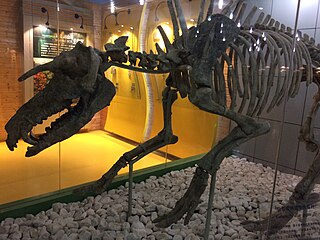
Chevrotains, or mouse-deer, are diminutive, even-toed ungulates that make up the family Tragulidae, and are the only living members of the infraorder Tragulina. The 10 extant species are placed in three genera, but several species also are known only from fossils. The extant species are found in forests in South and Southeast Asia; a single species, the water chevrotain, is found in the rainforests of Central and West Africa. They are solitary, or live in loose groupings or pairs, and feed almost exclusively on plant material. Chevrotains are the smallest hoofed mammals in the world. The Asian species weigh between 0.7 and 8.0 kg, while the African chevrotain is considerably larger, at 7–16 kg (15–35 lb). With an average length of 45 cm (18 in) and an average height of 30 cm (12 in), the Java mouse-deer is the smallest surviving ungulate (hoofed) mammal, as well as the smallest artiodactyl. Despite their common name of "mouse deer", they are not closely related to true deer.

Orycteropodidae is a family of afrotherian mammals. Although there are many fossil species, the only species surviving today is the aardvark, Orycteropus afer. Orycteropodidae is recognized as the only family within the order Tubulidentata, so the two are effectively synonyms.

Ostriches are large flightless birds. They are the heaviest and largest living birds, with adult common ostriches weighing anywhere between 140-320 lbs and laying the largest eggs of any living land animal. With the ability to run at 70 km/h (43.5 mph), they are the fastest birds on land. They are farmed worldwide, with significant industries in the Philippines and in Namibia. Ostrich leather is a lucrative commodity, and the large feathers are used as plumes for the decoration of ceremonial headgear. Ostrich eggs have been used by humans for millennia.

Megistotherium is an extinct genus of hyaenodont belonging to the family Hyainailouridae that lived in Africa.
Bathyergoides is an extinct genus of rodent from Africa thought to be related to the modern blesmols. It is the only member of the family Bathyergoididae. Fossils of Bathyergoides neotertiarius were recovered from the Early Miocene Elisabeth Bay Formation of Namibia.

Kubanochoerus is an extinct genus of large, long-legged suid artiodactyl mammal from the Miocene of Eurasia and Africa.

Indopithecus giganteus is an extinct species of large ape that lived in the late Miocene of the Siwalik Hills in northern India. Although frequently assigned to the more well-known genus Gigantopithecus, recent authors consider it to be a distinct genus in its own right.

Martin Pickford is a lecturer in the Chair of Paleoanthropology and Prehistory at the Collège de France and honorary affiliate at the Département Histoire de la Terre in the Muséum national d'Histoire. In 2001, Martin Pickford together with Brigitte Senut and their team discovered Orrorin tugenensis, a hominid primate species dated between 5.8 and 6.2 million years ago and a potential ancestor of the genus Australopithecus.
Aegyrcitherium is an extinct genus of prehistoric rhinoceros endemic to Europe during the Miocene living from 16.9—16 mya existing for approximately 0.9 million years.

Ysengrinia is an extinct genus of carnivoran in the family Amphicyonidae (beardogs), which lived in Europe, Asia, and North America during the Early Miocene. It was also reported from Egypt and Namibia, but this material has been reassigned to other genera of beardogs.
Megalochoerus is an extinct genus of large and long-legged pig-like animals from the Miocene of Africa.

Conohyus was an extinct genus of suid that existed during the Miocene in Europe and in Asia.

Hyainailouridae ("hyena-cats") is a family of extinct predatory mammals within the superfamily Hyainailouroidea within extinct order Hyaenodonta. Hyaenodontids arose during the middle Eocene and persisted well into the middle Miocene. Fossils of this group have been found in Asia, Africa, North America and Europe.
Isohyaenodon is an extinct polyphyletic genus of hyainailourid hyaenodont mammal from the subfamily Hyainailourinae). Remains are known from early to middle Miocene deposits in Kenya, East Africa.
Versoporcus was an extinct genus of even-toed ungulates that existed during the Miocene in Europe. Two species are recognized, V. grivensis and V. steinheimensis.

Nyanzapithecus pickfordi is an extinct species of primate from the Middle Miocene of Maboko Island, Nyanza Province, Kenya. It had an average body mass of around 10 kg (22 lb).

Dissopsalini is an extinct tribe of teratodontid hyaenodonts. Fossil remains of these mammals are known from early to late Miocene deposits in Asia and Africa.

Hyainailourinae ("hyena-cats") is an extinct subfamily of hyainailourid hyaenodonts that lived in Africa, Asia, North America and Europe from the middle Eocene to middle Miocene. They appeared in Africa about 47.8 Ma ago and soon after spread as far as East Asia.
Diamantofelis is an extinct genus of felids that lived in what is now Namibia during the Early Miocene. It contains a single species, Diamantofelis ferox.
Namafelis is an extinct genus of felids that lived in what is now Namibia during the Early Miocene. It contains a single species, Namafelis minor. Closely related to Diamantofelis, it is of “Pseudaelurus-grade”, and therefore a rather basal member of the cat family.










